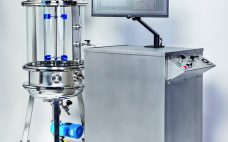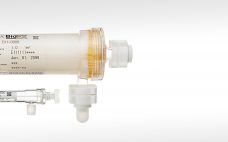In recent years the biopharmaceutical industry has significantly increased the demands it makes on bioreactor systems. Efficient and reproducible production of active pharmaceuticals of high quality and in large quantities is of highest priority. However, bioprocessing is a complex topic. Numerous factors affect growth of cells in culture but are difficult to determine and interpret reliably. One of the most relevant performance parameters is the volumetric mass transfer coefficient (kLa). It describes the efficiency of gas transfer (e.g., oxygen) from…
Sponsored Content
Ask the Expert on Ceramic Hydroxyapatite Chromatography Media: How to Start
Bio-Rad’s CHT Ceramic Hydroxyapatite XT (CHT XT) calcium-affinity cation-exchange chromatography medium is used for purifying numerous types of biomolecules, with single-step clearance of impurities and aggregates in monoclonal antibody (MAb) purification. This is an easy-to-use mixed-mode medium, which is both ligand and support matrix in one. In an “Ask the Expert” webinar on 18 July 2018, Mark Snyder (manager of the process chromatography R&D applications group at Bio-Rad Laboratories) discussed its application and use at process scale, providing guidelines on…
Ask the Expert: Key Considerations for Advanced Therapies Manufacturing
On 12 September 2018, Thomas Page, PhD (vice president of engineering and asset development at Fujifilm Diosynth Biotechnologies, FDB) shared a brief overview of challenges encountered in manufacturing of advanced biotherapeutics. Page’s Presentation FDB is a contract and development manufacturing organization (CDMO) that uses microbial and mammalian cell lines to produce protein therapeutics as well as viral vaccines and gene therapies. The company’s Center of Excellence for Advance Therapies Manufacturing is located in Texas. FDB set out some years ago…
Ask the Expert: Bioproduction Efficiencies Gained Using ExpiCHO Stable Production Medium
The transition from transient to stable production workflow with Chinese hamster ovary (CHO) cells requires a change in culture medium. On 22 August 2018, Shreya Lowmaster (field applications scientist at Thermo Fisher Scientific) discussed transient to stable solutions for moving from research to commercial production. Lowmaster’s Presentation Researchers are demanding higher titers in transient systems, and many people use CHO systems as an alternative to HEK293 cells. The Thermo Fisher Gibco ExpiCHO Expression System kit was developed for transient expressing…
Culture of 3D Cell Aggregates in Perfusion in a DASbox® Mini Bioreactor System
Three-dimensional (3D) cell aggregates are of great interest for many applications, including disease modeling, drug toxicity assessment, and manufacturing of stem cell-based products. Stirred-tank bioreactors are promising culture systems for 3D cell aggregates, as they allow efficient establishment and maintenance of cell aggregates, process monitoring and control, and process scale-up to larger volumes. Furthermore, they can be operated in perfusion mode, which allows 3D cell aggregates to be sustained longer than in traditional batch cultures. Researchers at the Instituto de…
Dynamic Dialysis: A Novel Process-Scale Membrane Separation for GMP Manufacturing
This webcast features: Daniel (Danny) Spurgin, Product Manager, and Cassidy Markee, Bioprocess Sales Specialist, Repligen While static dialysis is used routinely in research and sample analysis, dynamic dialysis is increasingly used today for the purification of macromolecules, proteins, nanoparticles, biomolecules, polymers (polypeptides, polysacharide, oligos), virus for vaccine and delicate/shear sensitive species. It is also ideal for the purification of viscous fluids and hydrogels (hyaluronic acid – HA) that cannot be filtered. Where traditional filtration methods may fail, dynamic dialysis uses…
Single-Use Sensors and Control and Data Acquisition Tools to Streamline Bioprocess Development
Process development and biomanufacturing in the biopharmaceutical industry have evolved extensively over the past 10 years. More tools are available to study process variables to enable more efficient and productive processes, speed development, and reduce costs. High powered microcontrollers are embedded in laboratory devices to carry out complex tasks. Recently, users have started working with microcontrollers such as Raspberry Pi for personal projects. As personal computer power has accelerated multiplefold,leading to high processing power and compact, high-capacity memory readily available…
Minimizing Resources in Developing Commercial Virus Filtration Processes with Planova BioEX
This webcast features: Roya Dayani, Senior Product Manager, Asahi Kasei Bioprocess Europe Establishing a virus filtration step in biopharmaceutical development and manufacturing process may require a large amount of resources (i.e., time, manpower and cost). These can be minimized with swift process development, smooth scale-up and worry-free operations. In this webinar Asahi Kasei Bioprocess will answer the question “What are the main requirements for a virus filter at each phase?”. You will learn through different case studies the filtration performances…
New High Performance AEX Resin for Large Biomolecule Purification
This webcast features: Jiali Liao, Principal Scientist, Process Chromatography R&D, Bio-Rad Laboratories Large molecule purification can be difficult due to their size. This leads to slow diffusion and mass transfer kinetics of the molecules into the pores of traditional chromatography resins, which decreases their binding capacity and resolution. In this webinar, Dr. Jiali Liao will introduce the design features of the Nuvia HP-Q bead matrix that help overcome these purification challenges. Case studies on plasma protein and virus purification will…
The Effect of Albumin on Viability in Stem Cell Therapy
Stem cell therapies are some of the most cutting-edge and sophisticated therapeutic developments. They offer an attractive alternative approach to more widely used treatments for conditions such as multiple sclerosis, metabolic diseases, cardiovascular disease, liver disease, and cancer. But developers still face challenges, some of which can be addressed by the use of recombinant human albumin. As a long-established ingredient of cell culture media, albumin is well recognized for its ability to facilitate growth of many cell types. The industry is expanding its use of high-quality, fully recombinant, current good manufacturing practice…







